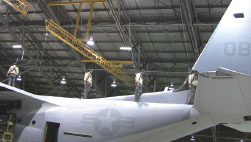New developments are helping stop the sudden stop.
By Mark Robins
Overhead Protection
 At many hangar facilities, floor space is limited and the need to minimize equipment in the work area is a significant concern. More and more, organizations are minimizing floor-supported fall protection and replacing it with overhead fall protection supported by the hangar roof structure.
At many hangar facilities, floor space is limited and the need to minimize equipment in the work area is a significant concern. More and more, organizations are minimizing floor-supported fall protection and replacing it with overhead fall protection supported by the hangar roof structure.
There are many different types of overhead fall protection products available to suit various applications. “Most systems are mounted in fixed positions over the wings and fuselage areas to cover aircraft of similar size. There are articulating systems designed to accommodate aircraft of different sizes and parking configurations,” says Richard Gass, director of engineering, Fall Protection Systems Corp., Florissant, Mo. “When working at elevated heights, changing heights or working on contoured horizontal surfaces can be hazardous when using platforms or lifts. They simply cannot provide protection in every situation. Overhead fall protection when designed properly, can protect individuals starting at floor elevation.”
There are new portable systems entering the market which Gass believes can provide a quick and easy option to provide coverage in a localized overhead working surface. They can be easily moved from location to location, in many cases without assembly or disassembly. They can be used for indoor and outdoor applications, providing an affordable means to address a hazardous condition. Gass recommends asking for references and examples of fall protection systems to verify performance.
User Friendly and Non-Intrusive
New fall protection system designs are easier and more comfortable to use in aviation maintenance. Because of this, fall protection is becoming more readily accepted, and easier to implement and monitor within a company’s culture.
Over the last few years, there have been several new harness designs on the market. “Many of these harnesses are lighter with additional padding and webbing to make the units much more comfortable to wear,” Gass says. “Many of the harnesses are available in different sizes and designed for many types of work environments. Also, taglines mounted in convenient locations allow the safety hook to be attached on the ground, ensuring that users are protected before moving into an elevated position. When possible, avoid placing users in an elevated position and then hooking up to the fall protection system; hooking up can sometimes place a person in an awkward position.”
Joe Yeatman, product manager of systems and anchors at Capital Safety, Bloomington, Minn. believes advances in fall protection were required in order to meet the stringent operational demands of the manufacturers, air carriers and MROs, as well as to match the technological progress of the aviation industry.
He says some of these advances include:
• Harnesses that are lighter weight and padded for comfort, equipped with locking chest and leg straps to maintain adjustment
• Trauma straps for increased suspension tolerance should an individual experience a fall arrest
• Different sizes for different body types
• Harnesses by type of work performed: non-conducting harnesses for electrical work, confined space harnesses, Kevlar harnesses made for welding and general industry harnesses of various types
“Most equipment is designed for simple and failsafe operation,” Yeatman says. “Most modern fall protection systems take human factors into consideration, and are designed, engineered and manufactured utilizing strict quality control standards. Capital Safety strives to reduce equipment complexity and help reduce errors while using the equipment. Being user friendly means more time for productivity.”